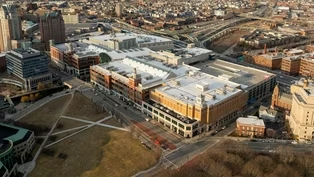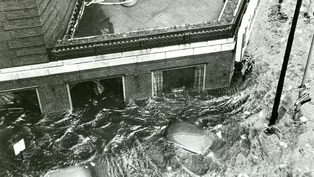
Brutal Buildings
Clip: Season 4 Episode 2 | 8m 47sVideo has Closed Captions
In Providence, a small number of its Brutalist Buildings are still standing.
Brutalism, a style of architecture popularized in the 1950s and 60s, is fading in many parts of the country. In Providence, a select few Brutalist buildings are still standing. Ben Berke takes a walking tour of the city's Brutalist history with J. Hogue of Art in Ruins.
Problems playing video? | Closed Captioning Feedback
Problems playing video? | Closed Captioning Feedback
Art Inc. is a local public television program presented by Ocean State Media

Brutal Buildings
Clip: Season 4 Episode 2 | 8m 47sVideo has Closed Captions
Brutalism, a style of architecture popularized in the 1950s and 60s, is fading in many parts of the country. In Providence, a select few Brutalist buildings are still standing. Ben Berke takes a walking tour of the city's Brutalist history with J. Hogue of Art in Ruins.
Problems playing video? | Closed Captioning Feedback
How to Watch Art Inc.
Art Inc. is available to stream on pbs.org and the free PBS App, available on iPhone, Apple TV, Android TV, Android smartphones, Amazon Fire TV, Amazon Fire Tablet, Roku, Samsung Smart TV, and Vizio.
Providing Support for PBS.org
Learn Moreabout PBS online sponsorship(tone beeping) (grandeur orchestral music) - [J. Hogue] I think brutalism is a real encapsulation of what we thought the future would be.
(tone beeping) It's a very different aesthetic.
Our eyes have been trained to value a certain kind of architecture.
(grandeur orchestral music) - [Ben] You may have heard about brutalism for the first time recently, but what really is it?
- And the Oscar goes to "The Brutalist."
- "The Brutalist."
- Adrien Brody.
(audience cheering and applauding) - [Ben] It's the style of architecture at the center of the Oscar winning movie, "The Brutalist."
But behind these buildings were architects like Paul Rudolph, designing what they thought the future would look like.
(grandeur orchestral music) So, I'm on a walk with J. Hogue, the creator of ArtInRuins.com, to look at some of these examples of brutalist architecture here in Rhode Island and understand why they look this way.
(grandeur orchestral music) J, what exactly is Art in Ruins?
- [J. Hogue] Art in Ruins is a website I started about 20 years ago.
And the point for me has been really to document the architectural change and the landscape around Providence.
- And why do people go on your website?
- I think part of it is nostalgia.
There's always a little bit of romanticism to it.
These places mean things to people, and they mean all sorts of different things, but they're still really important part of life that needs to be captured.
- [Ben] So, J, this is our first stop.
- [J. Hogue] Yeah.
- [Ben] Where are we?
(intriguing techno-synth music) - [J. Hogue] So we're in front of the Beneficent House.
(intriguing techno-synth music) - [Ben] Designed in 1963 by Paul Rudolph, the Beneficent House is one of the few brutalist buildings that's still standing in downtown Providence.
(intriguing techno-synth music) What makes a building brutalist?
- I think we have to remember, at the time, architects have always been really invested in technology and new construction methods, and brutalism, at the time, came about because concrete was affordable and plentiful, and could do things structurally that couldn't be done before.
(bright orchestral upbeat music) - [Ben] And what specifically was Rudolph trying to do in creating these shapes within this building?
- [J. Hogue] The square, blocky forms are very stark, the structure itself feels very powerful.
There is some edginess and rawness to it, but the brick, I feel like, does give it a lot of warmth that a raw concrete treatment may not have done otherwise.
(tranquil upbeat music) - How did they fit this into a historic neighborhood like downtown Providence?
- By demolishing everything that was here.
This was undoubtedly part of a big urban renewal project in the 1950s and '60s that gave them the ability to knock down large parcels of land and rethink them.
(tranquil upbeat music) - J, what's the next piece of brutalism you wanna show us?
- Yeah, the next place I'd like to show, you know, I feel like this is a really great example, a positive example, of brutalism, Cathedral Square, I feel like is the opposite of that.
It's more on the failure end of things, they had great intentions, but they didn't quite play out.
So I think that's where I'd like to take you next.
- Let's go see it.
(intriguing orchestral music) What is this corridor space we're walking in right now?
- Yeah, we're walking through a pedestrian mall, or the remnants of a pedestrian mall, that actually included all of Westminster Street behind us.
(intriguing upbeat music) - [Ben] Do we have the civic plaza that they envisioned?
- No, unfortunately not.
(intriguing upbeat music) They, at the time, really felt like retail, and shopping, and those newer activities would be replacing industrial activities, which the city was really built on.
Actual retail shopping in downtown dwindled, and the pedestrian wall didn't help keep those stores open.
(intriguing upbeat music) - What is it used for today?
What do you see when you come here?
- Not used for too much.
It feels large and empty most of the time, instead of as active as what they had wanted.
(intriguing upbeat music) - [Ben] How does this space fit into the brutalist style?
- There are undertones of brutalism here.
With the buildings surrounding us, we can see they're very blocky, not a lot of ornamentation, really square.
- J, you've showed me some brutalism you like, you've showed me some brutalism you don't like.
Where are we going next?
- Sure.
Yeah, I'd like to show you some brutalism that's not there anymore.
We'll be going to the site of the former John Fogarty Memorial Building.
- Let's hit it.
- Okay.
(intriguing upbeat-rock music) - All right, J, we're almost here.
- Yeah.
- What are we about to go look at?
- So, I'll show you some pictures of the building that used to be here, and probably read some comments as well.
I think it helps paint the picture of sometimes why brutalism can get a bad rep. (intriguing upbeat-rock music) - When was this place demolished?
- It was demolished in 2017, built in 1967, and they put a pretty big hotel up in its spot instead.
- [Ben] Was there much of an effort to preserve the Fogarty building?
- There was, actually.
There was a group that held a "funeral," quote-unquote, for it, at the time when it was clear that they were not gonna be successful with it.
Architecturally, it was interesting, 'cause it was a form of brutalism as well, it was another example of the way that I think a lot of municipal government buildings used that style of architecture to kind of make a statement that they were modern, and bring this style of architecture to them that felt very new at the time and very cutting edge.
- So what have you heard from people about what the Fogarty building meant to them?
- Yeah, I've got a few comments about it.
So the first one from someone named Ann; "For those of us who worked there as caseworkers, it was a place like none other, and it was the saddest of days when it was razed."
And then on the opposite side, from John, "This building used to facilitate the state welfare office.
Growing up pretty poor, me and many I know can remember spending many grueling hours in early '80s, sitting, playing in multicolored plastic chairs in a vast waiting room."
I really value the comments that I get from people, because that's someone who's worked there, used that facility, visited time and time again, they have a completely different experience.
And so, I like to hear the different kinds of connections that people have with all of these places.
(intriguing orchestral music) - So this was the old Bonanza Bus Terminal?
- [J. Hogue] Yeah, it was a centrally located bus terminal for people coming in and out of the city.
(intriguing orchestral music) In the '90s, when they started to remake downtown, yet again, it was decided that a convention center would be a better use of the space.
But it was a interesting example of mid-century modernism meeting brutalism.
(intriguing orchestral music) - [Ben] Are we in danger of losing most of our brutalist structures in Rhode Island?
- I think we could be, yeah.
I think if people don't start to look at them, as they're becoming 50 years old or older now, the same way that we look at historic structures from the 1880s, 1900s, we could lose quite a few more of them.
(intriguing orchestral music) - Does Providence have especially rich heritage of brutalism?
- We don't have a lot of examples, but I think what we have going for us is a very strong preservation mindset.
So I think that fabric is really what's the most important thing to probably try to preserve.
(intriguing orchestral music) (street bustling) (static whirring) (upbeat western music)
Video has Closed Captions
Clip: S4 Ep2 | 6m 42s | Explore themes of artist housing displacement through Michael Townsend's unique view. (6m 42s)
Video has Closed Captions
Clip: S4 Ep2 | 6m 48s | Learn about the history of documentary photography. (6m 48s)
Providing Support for PBS.org
Learn Moreabout PBS online sponsorshipSupport for PBS provided by:
Art Inc. is a local public television program presented by Ocean State Media

















